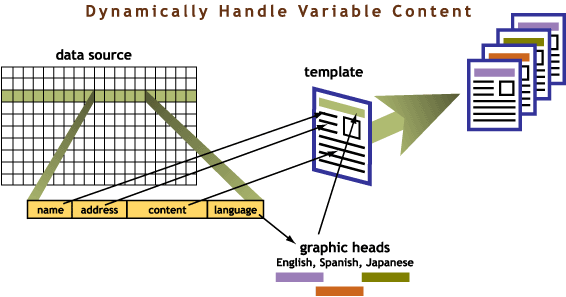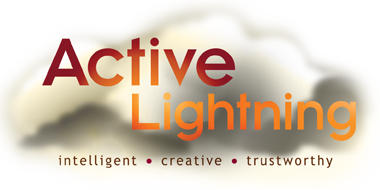Automated Publishing
Variable Data Printing
Active Lightning can produce the software that your company needs to do a variable data printing project. Typically, the software in support of variable data printing is part of an overall content management system.
When does a company need variable data publishing?
When there is a need for long print runs (to produce many units)
and there is a need for content to vary from one unit to the other
then there is a need for variable data printing. See the graphic below.

| * For static content, the digital master can be a file from InDesign or QuarkXPress, however, the trend in the print industry is towards using pdf files. See below for more on the value of using pdf files. |
Variable data printing offers the ability to:
• tailor high-end marketing communication to individuals
• customize catalog content
• communicate to different target markets with the same design and data system
• produce updated marketing materials quickly
• rapidly extract data from different departments to produce marketing communication
How it works
The graphic below shows one data source. In reality, the production process can use multiple data sources. We can establish a dynamic link to one or more databases (via ODBC). Or if security is an issue, the relevant data can be exported and supplied to the process. Then Active Lightning software ties into the data sources and generates document files. A professional printer takes these files and uses them to do the variable data press run.

Consider the method for doing a “mail merge” in Microsoft Word. The process for variable data publishing (or database publishing) is similar, but more sophisticated. There is a data source which can be anything from an Excel spreadsheet to a big Oracle database. A template informs the design of the different versions. In a mail-merge, the template provides a static design, just the data-values change. In variable data publishing, many aspects of design can be driven by data. The illustration above shows that the image file for the heading changes based on what "language" is given in the data record. Additionally, the page layout, the paragraph style, or table style can change from document to document depending on the target data-values.
The automation (executable software) tells the process how to construct the document based on the data values that are retrieved from the data sources—both content and design. Automation is available for the final pdf documents that get sent to a printer, XML libraries, or Illustrator images.
Variable RIP
When a file is sent to a digital printing press, it must be RIPed. “RIP” stands for Raster Image Processor. A RIP is a translation process to convert a document file into the machine language that the printing press requires.
When some of the content stays the same for each unit, and some varies, then variable data printing techniques allow the static content to be RIPed once. Then the variable content which needs to be RIPed for each unit is then a smaller piece of the whole and the print process goes faster. (When the content on each page is 100% variable, then each page has to be RIPed anyway.) Therefore, variable data printing:
• reduces throughput time
• optimizes the print process so that it is faster and cheaper
The extra work and expense to produce document files that enable a variable data RIP process
Active Lightning Services
Active Lightning provides the following services:
- Create or modify a database to manage the information needed for
both business operations and publishing projects - Create the processing to export desired information from an existing
database for a variable-data project - Create a template via PPML, InDesign, or FrameMaker (for PDF output) that will
produce the desired design of the communication piece - Create processing via PatternStream to create print-ready PDF files
without manual labor - Work with a PPML-savvy printer to create PPML processing that
works with the RIP and press
Printers
Active Lightning works with a company’s preferred printer to deliver files with the appropriate specifications. Following are some printers that Active Lightning can recommend for variable data printing projects.
Electric City Printing |
Founded in 1935, Electric City Printing is located in Williamston, SC. They have 14 presses (including 2 Indigo presses) and 21 skilled operators working 24 hours a day, 5 days per week. They participated in a variable data print study conducted by a professor from Clemson University. |
|
University Graphic Systems |
For a low-cost alternative, consider this student-run operation in San Luis Obispo, CA. The presses are donated by the respective manufacturers which leads to lower costs of production. They include a Xeikon, 2 DocuColors, a Heidelberg Speedmaster 74, and a Heidelberg DI. An HP3000 is coming soon. (Production time is from 6 pm to 2 am PST.) They did the printing for Reason magazine's newsworthy variable-data-print project. |
|
Lexington Press |
Founded in 1928, The Lexington Press was one of the first small independent printers to buy an Indigo press. They have extensive experience with personalized printing and on-press customization. They provide attentive oversight to the details of a variable-data project and excellent customer service. |
Industry Standards
The high-quality digital print industry is in the process of trying to establish the following standards. These definitions are taken from Introduction to the Personalized Print Markup Language: The PPPML Family of XML Standards.
| PPML |
(Personalized Print Markup Language) is an industry-standard language for digital print, developed by PODi (a consortium of leading companies in digital printing). It is a print content language, based on XML, that defines what goes on which page of which documents, using logical structured XML data. Related standards in the PPML family include PPML Templating and the Digital Print Ticket (DPT) application of JDF. |
|
JDF |
(Job Definition Format) is a data format for job ticketing, not for page content. It is designed as a universal format for exchanging information between system components in the graphic arts, where a job typically consists of many identical copies of one master. JDF has no constructs or parameters for generating the print stream; it implicitly presumes the document master is a resource that was created before the job enters production. |
|
UP3I |
(Universal Printer, Pre- and Postprocessing Interface) is a physical layer standard based on iEEE 1394 (also known as Firewire or iLink). UP3I is not a print language like PPML, nor is it a job ticket like JDF or its DPT subset. Rather, UP3I is a means of transfer of control data for pre- and post processing devices. It does not have any logical construct for workflow or document content. |
PDF File Format
Another standard that has already gained widespread acceptance is PDF. Following are some benefits of the PDF format versus other possible formats.
- Slim digital memory size
- Cross-platform, multi-system compatibility; usability is independent of operating system
- Graphics and fonts are embedded, avoids missing files, facilitates better document management
- Can be created from any source application, including QuarkXPress, InDesign, FrameMaker, database reports, and Word, although proper control over the print process (color space, linescreen, trapping, etc.) requires generation from a desktop-publishing application
- Fixed against easy errors but still allows editing with full Acrobat
- Better pre-press efficiency, can do prepress proof without waiting for a file to spool to an imagesetter
- Pre-flight control available through PitStop Professional by Enfocus
- Enables cheap low-res printed proof
- Provides easy hi-re, low-res control from same source
- Can be signed with a legally-valid digital signature, if desired
- Can lock the document to require a password, if desired
- Delivers prepress control: linescreen monitoring, color checks, trap overrides, font replacement, dot-print gain, darkness of black plate
- Precision and reliability of postscript technology
- Internet-browser-compatible, can view on the internet (with free browser plug-in, Acrobat Reader)
Excellent Value for the Money
Active Lightning custom solutions provide excellent value for the money. Generally, small companies can afford them. See our hourly work rates. Usually, our clients order work on a fixed-price basis. In this case, the project objectives are conveyed through one or more phone conversations; then, Active Lightning formalizes the specifications of the project in a proposal/quote. The client can then review the document to see if it matches expectations and caps costs at a reasonable level.
Possible, Practical, Affordable
Variable data printing enables a company to do targeted marketing and 1-to-1 marketing. Active Lightning offers variable data solutions that are custom-tailored to a company’s desires and needs. Active Lightning makes it possible, practical, and affordable to do the document generation required for a variable data printing project.
